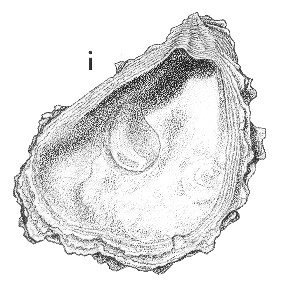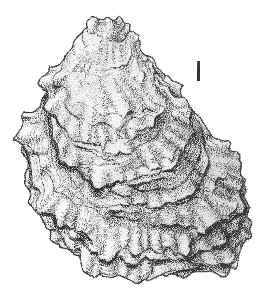
Revised descriptions of New Zealand Cenozoic Mollusca from Beu and Maxwell (1990)

 | Revised descriptions of New Zealand Cenozoic Mollusca from Beu and Maxwell (1990) | 
|
  (Pl. 44i): GS208, R22/f7379, Castlecliff, Wanganui, Castlecliffian (almost certainly from Tainui Shellbed) (GNS) |
  (Pl. 44l): GS208, R22/f7379, Castlecliff, Wanganui, Castlecliffian (almost certainly from Tainui Shellbed) (GNS) |
Beu & Maxwell (1990): Chapter 16; p. 340; pl. 44 i, l.
Synonymy: Ostrea chilensis Philippi in Kűster, 1844, wrapper of Lief. 45; Ostrea lutaria Hutton 1873a, p. 84; O. virginica (not of Lamarck) of Hutton 1873a, p. 84; O. corrugata Hutton 1873b, p. 35 (not of Brocchi, 1814); O. discoidea (not of Gould) of Hutton 1880, p. 175; O. edulis (not of Linné) of Hutton 1880, p. 175; O. angasi (not of Sowerby), O. hyotis (not of Linné), and O. reniformis (not of Sowerby) of Suter 1913c, p. 888-892; Ostrea tatei Suter 1913c, p. 889, in part (Suter's type is an Australian Eocene fossil, the holotype of O. hippopus Tate, 1886, not of Lamarck); O. sinuata of Finlay 1928b, p. 264 (not of Lamarck); O. fococarens Finlay 1928b, p. 264 (footnote) (new name for O. corrugata Hutton, preoccupied); O. heffordi Finlay 1928b, p. 265; O. charlottae Finlay 1928b, p. 265; O. huttoni Lamy 1929, p. 166 (new name for O. corrugata Hutton, preoccupied); Tiostrea chilensis lutaria, Beu & Maxwell 1990, p. 340, pl. 44i, l.
Type species of Tiostrea Chanley & Dinamani, 1980 (= Ostrea; O'Foighil & Taylor 2000; Kirkendale et al., 2004)
Classification: Ostreidae: Ostreinae
Description: Small to medium-sized for family (to c. 120 mm high), oval and (in most specimens) weakly inflated, but extremely variable in shape, depth, colour, and sculpture, according to environment; calcitic. Right valve almost flat, the only sculpture of wide, brittle lamellae; left valve shallowly to moderately cupped, with weak radial costae or no regular sculpture, bearing lamellate frills in some specimens. Cemented by left valve to substrate (as are all oysters) when young, but the substrate can be either low-tidal to subtidal rocks (in which case the adult remains attached, and grows into the heffordi form, or "Dunedin rock oyster"), or can be merely a shell fragment on softer substrate on the inner shelf, in which case the adult is free-lying, and in current-swept situations grows into the relatively smooth "dredge" or "Bluff" oyster, or in quiet environments into the charlottae form with elaborate frills, specially on the lower (left) valve (illustrated). Chomata very small, limited to margins near hinge, obliterated in old specimens. Hinge a large, irregularly triangular resilifer, with shallow, triangular central pit bordered by anterior and posterior ridges. No pallial line; large, weakly reniform adductor muscle scar slightly in front of middle of valve.
Comparison: The phylogeny of world dredge oysters has changed so markedly since Beu & Maxwell (1990) that this entire section has been rewritten. It is now recognised that Ostrea chilensis is a species of Ostrea (sensu stricto), closely related to the type species, O. edulis (Linnaeus, 1758) (O'Foighil & Taylor 2000; Kirkendale et al. 2004). It is distinguished by its brief larval life rather than having a long-lived planktotrophic larva. This species lives in Chile as well as New Zealand, despite its lack of a significant dispersal stage, and O'Foighil et al. (1999) suggested that specimens were rafted from New Zealand to Chile. The abrupt Late Miocene appearance in New Zealand suggests that a more likely scenario is that it was rafted to both New Zealand and Chile from an unknown location during Miocene time, or rafted to New Zealand first, and later from New Zealand to Chile attached to Durvillaea (macroalgal) holdfasts (Beu 2006, p. 211). This is the one moderate-sized, common oyster throughout New Zealand Pliocene and Pleistocene rocks and in the Recent fauna, easily recognised by its much smaller size than Crasostrea ingens, its thin shell, its small ligamental area and kidney-shaped muscle scar, and the prominent, roughly commarginal frills on the left (lower) valve of most specimens.
The species named Ostrea aupouria by Dinamani (1981) was placed in Ostreola Monterosato, 1884 by Torigoe (2004) and Kirkendale et al. (2004), using New Zealand material. However, Lapègue et al. (2006) and Shilts et al. (2007) demonstrated that it is a synonym of Ostrea stentina Payraudeau, 1826 (name based on material from the Mediterranean and E Atlantic to South Africa; = O. equestris Say, 1834, based on material from E North America; = O. spreta d’Orbigny, 1846, Argentina to Caribbean; = O. aupouria Dinamani (1981), NE North Island; = O. virescens Angas, 1868, E Australia). Beu (2006, p. 211) has previously recorded this species tentatively as a fossil (as O. virescens) at Table Cape, Mahia Peninsula, on the basis of two small valves. The difficulty of distinguishing this small oyster from small specimens of the larger, commercially important ‘flat oysters’ throughout its range has been emphasised by Lapègue et al. (2006) and Shilts et al. (2007). Shilts et al. (2007) concluded that (1) Ostreola Monterosato, 1884 is a synonym of Ostrea Linné, 1758, and (2) O. equestris and O. aupouria are synonyms of O. stentina. Torigoe (2004) had previously synonymised O. aupouria with O. virescens, so we assume that O. virescens is a further synonym of O. stentina. This, then, is another species occurring throughout the Mediterranean and on both shores of the Atlantic south to Argentina and South Africa, and transported in the Antarctic Circumpolar Current to Australia and New Zealand. Presumably, exceptionally in this case, rafting occurred on Durvillaea holdfasts (Donald et al. 2005) rather than as larvae, as O. stentina is a brooding oyster, without planktotrophic larvae.
The Neogene oysters recorded from New Zealand therefore are:
Ostreidae, Ostreinae: (1) Ostrea chilensis Philippi in Kűster, 1844, Tongaporutuan-Recent; (2) Ostrea stentina Payraudeaux, 1826, Holocene(?) and Recent; (3) Saccostrea glomerata (Gould, 1850), late Pleistocene (Hokianga Harbour, oxygen isotope stage 7) - Recent.
Ostreidae, Crassostreinae: (4) Crassostrea gigas (Thunberg, 1793), Castlecliffian, Ohope Beach, Bay of Plenty (oxygen isotope stage 15?); oxygen isotope stage 3?, Bay of Plenty; Recent; (5) Crassostrea ingens (Zittel, 1864), Tongaporutuan-early Nukumaruan.
Gryphaeidae, Pycnodonteinae: (6) Hyotisssa imbricata (Lamarck, 1819), late Pleistocene (oxygen isotope stage 7), Whangape Harbour, Northland (juvenile specimens attached to Pecten novaezelandiae).
Distribution: Late Tongaporutuan-Recent; Recent, New Zealand (types of O. lutaria, O. heffordi, O. charlottae); Te Araroa-East Cape coast, Kapitean (Beu 1981a; type of O. corrugata Hutton, not of Brocchi, = O. fococarens, = O. huttoni). Exceedingly abundant and widespread in Pliocene and Pleistocene rocks deposited in high-energy, shallow-water environments throughout New Zealand; the earliest known specimens are in late Tongaporutuan rocks in Wanganui basin.
Cite this publication as: "A.G. Beu and J.I. Raine (2009). Revised
descriptions of New Zealand Cenozoic Mollusca from Beu and Maxwell (1990). GNS
Science miscellaneous series no. 27."
© GNS Science, 2009
ISBN
978-0-478-19705-1
ISSN 1177-2441
(Included with a PDF facsimile file
copy of New Zealand Geological Survey Paleontological Bulletin 58 in CD version
from: Publications Officer, GNS Science, P.O. Box 30368 Lower Hutt, New
Zealand)